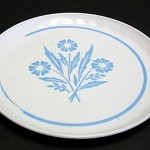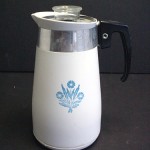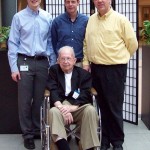Certain brands are recognized across the world, but often the people behind them are not exactly household names. Such is the case with CorningWare. Little did you know that each time you bake your favorite casserole, you have S. Donald Stookey, a Corning scientist, to thank for inventing the heat-resistant ceramic glass bowl you’re using.
Stookey died Thursday in an assisted-living facility in Rochester, NY, after complications following surgery for a broken hip. He was 99 years old.
But if anyone could leave behind a strong legacy, it’s Stookey. The versatility that his CorningWare has provided home cooks and gourmet chefs alike has long been celebrated in virtually every kitchen since the 1950s. And that won’t change any time soon.
- Plastic CorningWare Large Toy Plate, Corning Glass Works, Corning, NY, USA, about 1970-1979. Gift of Thomas P. Dimitroff. 2002.7.18 J.
- Plastic CorningWare Toy Pitcher with Lid, Corning Glass Works, Corning, NY, USA, about 1970-1979. Gift of Thomas P. Dimitroff. 2002.7.18 E.
Stookey began working as a research scientist at Corning Glass Works after receiving his doctorate in physical chemistry in 1940. His greatest breakthrough came, ironically, in the form of unbroken glass. In 1952, a furnace malfunctioned while he was heating a piece of plate glass, soaring more than 500 degrees higher than intended. Stookey was sure he’d find a pool of melted glass at the bottom of his furnace, but instead, he discovered an opaque, milky-white plate. He used tongs to remove it from the furnace, but somehow dropped it on the floor in the process. Much to his surprise, the glass didn’t shatter, but bounced.
That day, glass ceramics were born. Pyroceram, as Corning patented it, was used to create CorningWare by the end of the 1950s—a glass that could withstand extreme temperatures. It could be heated in the oven, on a stove burner, or in a microwave, and then be put in the freezer. It revolutionized the American kitchen; and it all started here in Corning thanks to one man.
Stookey’s interview in this “Stories from the Crystal City” video starts around 9:30.
Stookey was inducted into the National Inventors Hall of Fame in 2010, saying in an interview, “It’s a wonderful honor and I’m very happy, at my age of 94, to still be remembered for contributing something positive to research and to people’s everyday lives.”
Stookey’s accomplishments led Corning Incorporated to name an annual award after him, the highest honor in the technology community for exploratory research. Recent winners have made groundbreaking discoveries in environmentally-friendly LCD glass, diesel filter and substrate material, and products to enable biochemical research, according to Corning Incorporated’s website.
The Museum’s new chief scientist, Dr. G. Jane Cook, was honored with the Stookey Award last year. Although the details of her research remains proprietary, it involved work in several areas such as glass mixing, semiconductor processing, and metrology, all of which she was involved in during her 15 years at Corning Incorporated.
“The fact that I have been able to excel in exploring many areas of materials science is a direct result of inspiration from Dr. Stookey,” said Dr. Cook.
Dr. Cook recalls her first assignment upon entering graduate school in 1987 was to read a book given to her by her advisor who was a former Corning Glass Works scientist. It was Journey to the Center of the Crystal Ball, Dr. Stookey’s memoir describing his personal origins, his work at Corning, and his personal hobbies—“a portrait of a whole person,” as Dr. Cook describes it, “one who leveraged all aspects of the human experience for the creative, scientific, inventive process.”
Dr. Cook took the book to heart, and jumped at the chance to join Corning in 1998.
“It was my great privilege in my time at Corning to work side-by-side with Dr. Stookey’s protégés George Beall and Linda Pinckney on new glass ceramic material compositions and processing, even to have my name on a patent application with them,” Dr. Cook said. “Although I worked one-step removed from his direct tutelage, having Dr. Stookey as an ‘intellectual grandfather’ has had a tremendous effect and is a great honor.”
Dr. Cook will be heavily involved in the Specialty Glass Residency program between the Museum and Corning Incorporated, and says it is all thanks to Stookey’s influence, which has nurtured within her the will to keep discovering.
During the residency, this year’s artist, sculptor Albert Paley, was able to select from specialty glass patented by Corning, and although it wasn’t ultimately chosen, one glass that was examined was a newer glass-ceramic material, a direct descendent of the original Pyroceram invented by Stookey.
“It is my hope that in my research work at CMoG in the coming years, I can devise glass-ceramics and associated processes that are compatible with small glass studio capabilities,” said Dr. Cook, “and so extend Dr. Stookey’s discovery into entirely new realms of artistry, design, and utility.”
Thursday was the award ceremony for the 2014 Stookey Award, and Dr. Cook had just returned from attending the ceremony when she learned of Stookey’s passing.
“Last year’s event—my event—was the last that he made it to,” said Dr. Cook. “I am so glad and honored to have met and talked with Dr. Stookey, and to have received his personal congratulations last year when receiving his namesake award. He was kind and humble.”
- Dr. G. Jane Cook and fellow Stookey Award recipients John Maura and Scott Bickham meet Dr. Stookey.





5 comments » Write a comment